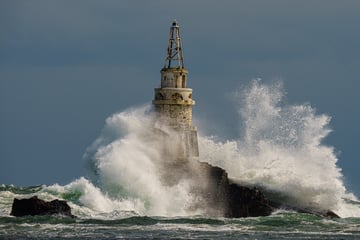To make weather forecasts, meteorologists use many resources to help them make smart decisions. The variety of data resources available today is incredible. The most important resource however is a weather map or a synoptic chart. This is the first tool that meteorologists use at the beginning of the working day. But what makes the synoptic chart a beloved resource for mariners as well?
The synoptic chart: a synopsis
All of us have ever seen weather charts with many lines of different colors and thicknesses. In fact, as you might have guessed, these lines don't actually exist. These lines were invented by meteorologists to make it easier to observe the synoptic elements of the atmosphere. Thanks to these lines, you can easily determine what kind of weather may be observed in a particular location, and you can also create a short- or long-term weather forecast.
Synoptic charts come in various types. The first, and perhaps the most used one, is the surface analysis chart. It shows the pressure at the ground level. The charts are further divided into charts of absolute (Figure 1) and relative (Figure 2) topography. Absolute topography charts show surfaces on which the atmospheric pressure is the same at all points. Using these charts, it is possible to determine the wind elements on various isobaric surfaces, predict the direction and speed of movement of surface baric formations, predict the occurrence and evolution of baric formations, determine the inclination of the axis of cyclones or anticyclones, determine air humidity and determine the position of the altitudinal frontal zone.
Relative topography charts show the elevation of one isobaric surface over another (geopotential height). Using these charts, it is possible to predict the evolution of surface baric formations, predict areas of pressure increase and decrease, determine the advection of heat or cold, and clarify the position of the high-altitude frontal zone. Figure 1. Absolute topography synoptic chart where the lines represent sea level pressure (hPa). Source: IMweather.
Figure 1. Absolute topography synoptic chart where the lines represent sea level pressure (hPa). Source: IMweather.
 Figure 2. Relative topography synoptic chart where black lines represent geopotential height (gpdm) and colors represent temperature (°C). Source: IMweather.
Figure 2. Relative topography synoptic chart where black lines represent geopotential height (gpdm) and colors represent temperature (°C). Source: IMweather.
The most commonly used are surface analysis charts that include the following elements: isobars (lines of equal pressure) and areas of high/low pressure and precipitation zones (see Figure 3). Sometimes, you may also see precipitation zones, which are represented here as well. There are also more advanced maps that can show additional meteorological features like weather fronts, air temperature, wind speed and wind direction, cloud base and much more.
 Figure 3. Synoptic chart representing lines of equal pressure (isobars), areas of low and high pressure and precipitation zones.
Figure 3. Synoptic chart representing lines of equal pressure (isobars), areas of low and high pressure and precipitation zones.
Thanks to even the simplest synoptic chart, you can get a lot of information about the weather over a fairly large area, helping to understand how the atmosphere moves and develops. Synoptic charts can be used absolutely everywhere, from work environments where weather forecasts play an important role, to ordinary applications in everyday life.
Why do mariners love synoptic charts so much?
When working on the open sea, it is very important to take into account that weather is crucial to the safety of all personnel, and important for working efficiently.
Every day, mariners use synoptic charts to get a general idea of today's weather and what to expect in the coming days. For example, on offshore platforms, if workers notice a possibility in significant deterioration of weather conditions, they compare weather charts with numerical forecasts. This helps them decide whether to suspend work and evacuate personnel to avoid serious incidents. Similarly, a ship's captain, upon seeing, for example, concentration of isobars along the route indicating high wind speeds, will consider the wind direction and decide whether to reduce speed or change course temporarily.
Synoptic charts can be enough when, for example, it is clear there is a storm approaching. A low pressure area with high concentrations of isobars mean high wind speeds, so in this case it is clear, that the working limits may be exceeded. It's also great to determine the confidence of the forecast in 1 go, by looking at the different wind directions surrounding a low. This you won't see with just a numerical forecast.
Additional forecasts
However, as soon as there is need in more detailed weather description, synoptic charts are just not sufficient. In this situations, it is crucial to use the numerical forecast as an addition. Numerical forecasts provide much more detailed description including many parameters, such as wind speed on different heights, wave characteristics (height, direction, period etc.), visibility, cloud base and more. As soon as there is need in more detailed weather description, synoptic charts are just not sufficient.
Thus, synoptic charts do not provide the most accurate forecast, but they are a simple source of important weather information for the next few days, which makes it possible to carry out effective, and most importantly safe work. That makes it such a beloved tool for meteorologists and mariners alike.




